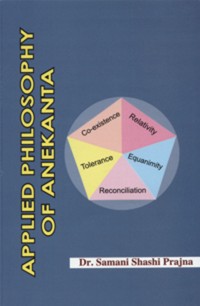Cultural clash is the fact of global reality. This is because our perception is always backed by our own cultural prejudices. This in turn hides many aspects of truth. Not only things remain in concealment because of prejudices, but it also generates controversies. In modern India, we come across a large number of conflicts between the Hindu and the Muslim in the name of religion and communal riots between the two states of the same country, in the name of language, cultural difference and so forth. Every country has its own culture and tradition. Problems erupt when one tries to impose it on the other. History tells us that events of this nature were commonplace.
Language is an essential and vital part of a culture. Usually people are proud of their mother tongue and do not like the domination of other language in their territory. The application of anekānta in this field, will amount to acceptance of other languages equivalent with their own language. No matter, what language or medium is used for communication as long as the message is understood properly. With language comes folk music, art, dance, drama and literature. The application of anekānta will mean to show equal enthusiasm in the folk music, dance etc. of all the countries and traditions. Cultural domination will cease to exist when all cultures are equally appreciated. This will help in building cultural ties and eradicating cultural conflicts. The main cause of violence is insistence over one’s views. This one-sided insistence over thoughts leads to mental agitation and which inturn reflects through verbal and physical or domestic violence.[1]
The Jaina concept of syādvāda implies that affirmation without negation and negation without affirmation is not possible. This is to say that we cannot understand our own philosophy, religion and culture unless we understand others. Therefore understanding others is as significant as understanding oneself. Similarly, it is the prevailing conflict that gives meaning to peace. Peace cannot be understood without conflict.Peace is something which the world eagerly wants,but does not know how to secure. Peace needs a new civilization, a new culture and a new philosophy, where there is no narrowness and no partiality. Huxley is correct to a great extent when he says that, ‘War exists because people wish it to exist’. We cannot check violence by remaining violent. But non-violence in action must precede non-violence in thought. R. Prasad also holds that sydvda is an extension of ahiṃsā in epistemology. Unless we resolve our differences, we are bound to face tension. Analysing the ultimate causes of war and terrorism, we had come to the conclusion that it is ultimately our divergent and conflicting ideologies that comes in the way. Conflict is an inherent human trait. Conflict arises due to incompatible interests, beliefs and customs. Nathmal Tatia also holds that only intellectual clarity will resolve all conflict and rivalry. Today one man or one country fights with the other because their views are different. Views are bound to differ because we are guided by different conditions, thoughts, modes and attitudes. Hence it is wrong to think oneself right and rest others as wrong. No one perspective is final or absolute, unless it is understood in terms of relativity. Understanding of different religions, cultures and value systems in the light of anekānta can help significantly in cultivating respect and tolerance for the people of alien notions, beliefs, cultures, religions and philosophies and can give full stop to clash of cultures.
 Dr. Samani Shashi Pragya
Dr. Samani Shashi Pragya

